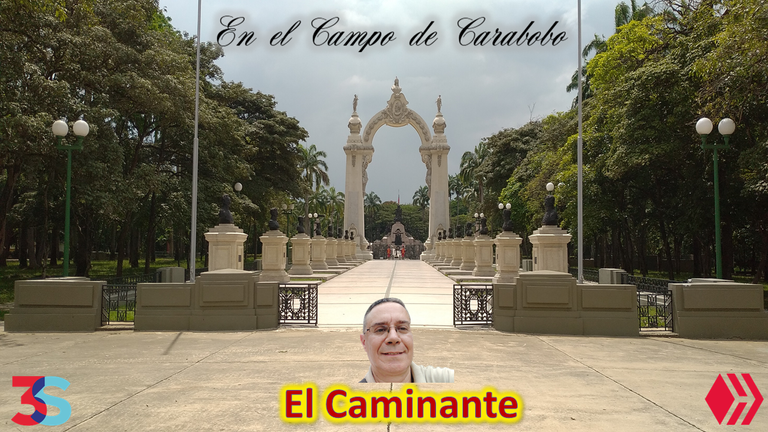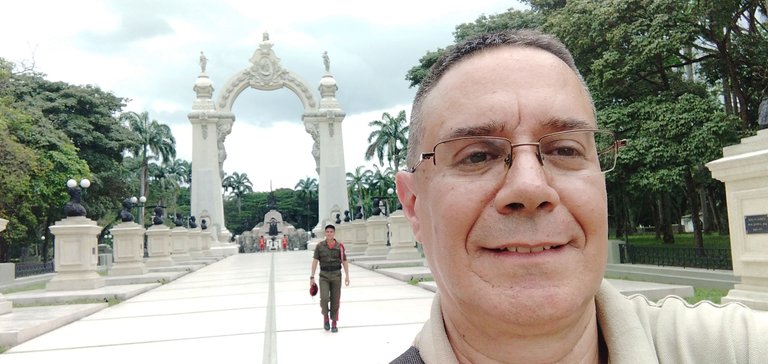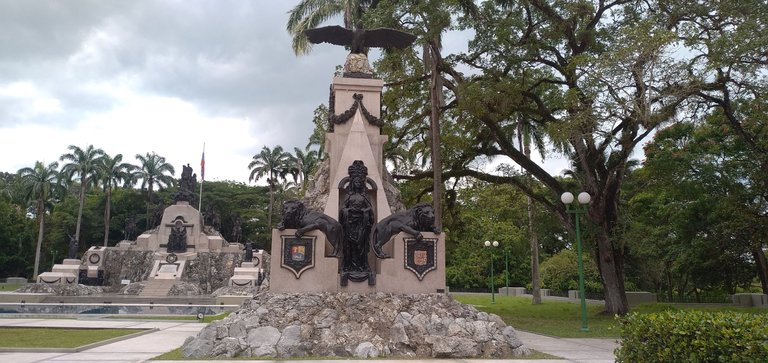
Buenos días, buenas tardes, buenas noches estimados amigos, un gran saludo a toda la comunidad de Hive, especialmente a la comunidad de EspaVlog.
Bienvenidos a este nuevo capítulo de esta sección llamada el Caminante, el cual vengo a demostrarles un lugar histórico y emblemático no solo de nuestra Caracas sino de nuestra Venezuela; es el lugar donde nació Venezuela, directamente desde el Campo de Carabobo, estado Carabobo, Venezuela. Los invito a que recorran conmigo cada uno de estos lugares para que conozcan un poco más de la historia del Campo de Carabobo ¡Vámonos!
Comenzamos con el relevo de la Guardia de Honor, el cual se efectuó el día sábado 15 de octubre de 2022, en el Campo de Carabobo, específicamente en el Arco de Carabobo, también conocido como el Arco del Triunfo, eran las 12 del mediodía, y se efectuaba el cambio de Guardia en el tradicional relevo de los Guardias de Honor, allí estuvimos un pequeño grupo de personas para presenciar ese hermoso espectáculo de patriotismo por parte de los jóvenes Guardias de Honor, el cual me dio mucho sentimiento al ver a esos soldados que con tanta disciplina y amor por la patria hicieron ese relevo.
Ahora bien, vengo entrando por la entrada principal donde está el Arco del Triunfo, del Campo de Carabobo, donde voy a ir demostrándoles cada una de esas esculturas representadas en bustos y cada uno de los nombres de los verdaderos próceres de la Independencia, que batallaron y lucharon por en la guerra de la Independencia de Venezuela. Aquí en el Campo de Carabobo se los voy a ir demostrando paso a paso para que vayan a ir conociendo parte de este recinto histórico de nuestra Venezuela.
Comenzamos con esta primera escultura, dedicado al prócer General de División Manuel Cedeño (1780-1821), él fue uno de los caído en la Batalla de Carabobo; seguimos recorriendo y tenemos la escultura del General en Jefe Rafael Urdaneta (1788-1845), aquí les presento al General de Brigada Pedro Briceño Méndez (1792-1835), ahora les presento al General en Jefe Bartolomé Salom (1780-1863), otro prócer verdadero de la Independencia, ahora nos vamos a ver al Coronel José Antonio Rangel (1789-1821), quien también murió en la Batalla de Carabobo, continuamos el recorrido y nos acercamos al busto del Coronel Juan José Rondón (1790-1822), continuamos conociendo otro prócer como el General de División Diego Ibarra (1798-1852), seguimos caminando y seguimos conociendo y aquí está nuestro gran famoso Teniente de Caballería Pedro Camejo, comúnmente conocido como el Negro Primero (1790-1821), él fue uno de los que derramó su sangre por nuestra liberación en la guerra de Independencia, nuestro querido y recordado Pedro Camejo.
Ahora pasamos por el Arco del Triunfo, 1921 el año cuando se edificó el Arco del Triunfo de nuestra Batalla de Carabobo, una escultura histórica y emblemática de nuestra Venezuela, seguimos recorriendo y seguimos presentando cada uno de los próceres de nuestra Independencia: Aquí está el General de Brigada Manuel Manrrique (1793-1823), seguimos recorriendo, seguimos caminando y aquí está el Coronel Miguel Antonio Vásquez (1786-1922), luego seguimos, y aquí está el General de División José Cornelio Muñoz (1795-1849), continuamos y aquí nos presentan al Coronel Thomas Ilderton Ferriar (1785-1821), fue otro de los que también murió por nuestra Independencia en el Campo de Carabobo, okey, seguimos y aquí está el General en Jefe Santiago Mariño (1788-1854), luego vemos al General en Jefe José Francisco Bermúdez (1782-1831), seguimos conociendo cada uno de los próceres de Independencia, aquí está el General de Brigada Ambrosio Plaza (1791-1821), fue otro de los héroes y mártires de nuestra Independencia y, luego terminamos este recorrido de estos próceres de Independencia con nuestro General en Jefe José Antonio Páez (1790-1873), llamado comúnmente como el Centauro de Los Llanos, quien también luchó y comandó esta Batalla de Carabobo, en este Campo de Carabobo, otro de los verdadero héroes de nuestra Independencia de Venezuela.
Continuamos el recorrido para seguir conociendo parte de estos monumentos históricos más emblemáticos y representativos de nuestra Venezuela. Aquí en este capítulo de esta sección del Caminante, se los estoy trayendo en vivo y en directo desde el Campo de Carabobo.
Ahora nos acercamos hacia el otro extremo para ir conociendo cada uno de estos monumentos. Okey amigos seguimos recorriendo y seguimos conociendo y vemos una escultura como una Reina en medio de dos Leones, pareciera que la Reina edificada fuera la Reina Maria Lionza y arriba se observa un ave parecida a un Águila. Seguimos el recorrido y seguimos conociendo cada uno de estos monumentos del Campo de Carabobo. Podemos observar un campo bastante espacioso, bien cuidado y bien conservado para el tiempo que tiene de construido, porque ese fue el lugar donde lucharon y batallaron nuestros próceres y héroes de la Independencia de Venezuela.
Seguimos viendo cada uno de estos monumentos a Carabobo, vamos a ir viendo estos espacios, ¡Esto es historia viva, señores!, historia verdadera de Venezuela. Aquí están como parte representativa de la Batalla de Carabobo por parte de nuestros héroes y patriotas contra los Realistas del ejército español, aquí están parte del monumento que los representa de manera simbólica de lo que fue la Batalla de Carabobo.
También se puede apreciar ese hermoso monumento dedicado a Carabobo. Porque el Gobierno Nacional edifica ese monumento altar de perenne veneración a la memoria de Bolívar y de los ínclitos guerreros que vencieron en Carabobo por la Independencia y por la gloria de Venezuela.
Para seguir recorriendo parte del Campo de Carabobo, les seguiré demostrándole los alrededores del monumento. Seguimos viendo los distintos espacios culturales que representa el monumento a Carabobo, en la cima se encuentra la estatua edificada a nombre del Libertador Simón Bolívar padre y héroe de la Patria.
Seguimos recorriendo y seguimos conociendo en esta sección llamada El Caminante en Carabobo, el cual vemos algunas estatuas que representa la victoria a Carabobo, la victoria de Venezuela, recuerden que este espacio es donde nació Venezuela, donde se libró la Batalla por la Independencia de Venezuela, aquí en el Campo de Carabobo. El cual se observa cada una estas obras y monumentos edificadas en nombre de nuestra Independencia; seguimos viendo y seguimos recorriendo.
Para finalizar quiero decirles que el Campo de Carabobo, se encuentra ubicada a unos 30 kilómetros al suroeste de Valencia, en el estado Carabobo, Venezuela, lugar donde se realizó la Batalla de Carabobo, donde se selló la Independencia de Venezuela, es un parque que tiene mucha vegetación, hermosos árboles y avenidas bastante espacioso, la cual es utilizada para los famosos desfiles militares que se efectúan cada 24 de junio en conmemoración de la Batalla de Carabobo, en ella se encuentran los héroes de la Patria a los que mencioné al comienzo de este video, también en esta escena podemos apreciar los monumentos y parte de las esculturas aquí demostrada. El Arco del Triunfo o Arco a Carabobo fue edificado en el año 1921 en conmemoración de los 100 años de la Batalla de Carabobo.
El Campo de Carabobo es un lugar que vale la pena visitar, se los recomiendo que vengan porque es un lugar muy hermoso y especial para conocer y hacer turismo, no solo por el legado histórico que nos dejaron nuestros próceres, sino por la belleza de sus parques y jardines dedicados a nuestros héroes y patriotas de este episodio histórico de nuestra Venezuela, como lo es el Campo de Carabobo.
Bueno estimados amigos, gracias por haber llegado hasta aquí y haber podido presenciar cada una de estas imágenes que nos ofrece el Campo de Carabobo, si les gustó el video no olviden suscribirse y dejar un comentario abajo en la casilla de los comentarios y los invito para un próximo capítulo de esta sección llamada El Caminante.
¡Se me cuidan mucho, les quiero mucho! Chao.
Good morning, good afternoon, good evening dear friends, a big greeting to all the Hive community, especially to the EspaVlog community.
Welcome to this new chapter of this section called the Walker, which I come to show you a historical and emblematic place not only of our Caracas but of our Venezuela; it is the place where Venezuela was born, directly from the Campo de Carabobo, Carabobo state, Venezuela. I invite you to walk with me through each of these places to learn a little more about the history of Campo de Carabobo. Let's go!
We started with the Guard of Honor Relay, which took place on Saturday October 15, 2022, in the Campo de Carabobo, specifically in the Arco de Carabobo, also known as the Arc of Triumph, it was 12 noon, and the change of Guard in the traditional relay of the Guards of Honor took place, There we were a small group of people to witness this beautiful show of patriotism by the young Honor Guards, which gave me a lot of feeling to see those soldiers who with so much discipline and love for the homeland made that relay.
Now, I am entering through the main entrance where the Triumphal Arch of Carabobo Field is, where I am going to show you each one of these sculptures represented in busts and each one of the names of the true heroes of the Independence, who fought and battled in the war of the Venezuelan Independence. Here in the Campo de Carabobo I am going to show you step by step so that you can get to know part of this historical precinct of our Venezuela.
We begin with this first sculpture, dedicated to the heroic Major General Manuel Cedeño (1780-1821), he was one of the fallen in the Battle of Carabobo; we continue touring and we have the sculpture of General in Chief Rafael Urdaneta (1788-1845), here I present Brigadier General Pedro Briceño Méndez (1792-1835), now I present General in Chief Bartolomé Salom (1780-1863), another true hero of the Independence, now we are going to see Colonel José Antonio Rangel (1789-1821), who also died in the Battle of Carabobo, we continue the tour and we approach the bust of Colonel Juan José Rondón (1790-1822), we continue to know another hero as Major General Diego Ibarra (1798-1852), we continue walking and we continue to know and here is our famous Cavalry Lieutenant Pedro Camejo, commonly known as the First Black (1790-1821), he was one of those who shed his blood for our liberation in the war of Independence, our beloved and remembered Pedro Camejo.
Now we pass by the Arc of Triumph, 1921 the year when the Arc of Triumph of our Battle of Carabobo was built, a historical and emblematic sculpture of our Venezuela, we continue touring and we continue presenting each of the heroes of our Independence: Here is Brigadier General Manuel Manrrique (1793-1823), we keep going, we keep walking and here is Colonel Miguel Antonio Vasquez (1786-1922), then we continue, and here is Major General Jose Cornelio Muñoz (1795-1849), we continue and here we are introduced to Colonel Thomas Ilderton Ferriar (1785-1821), he was another of those who also died for our Independence in the Carabobo Field, ok, we continue and here is the General in Chief Santiago Mariño (1788-1854), then we see the General in Chief José Francisco Bermúdez (1782-1831), we continue knowing each one of the heroes of Independence, here is Brigadier General Ambrosio Plaza (1791-1821), he was another of the heroes and martyrs of our Independence and then we finish this tour of these heroes of Independence with our General in Chief José Antonio Páez (1790-1873), commonly known as the Centaur of Los Llanos, who also fought and commanded this Battle of Carabobo, in this Carabobo Field, another of the true heroes of our Venezuelan Independence.
We continue the tour to continue knowing part of these most emblematic and representative historical monuments of our Venezuela. Here in this chapter of this section of the Walker, I am bringing you live and direct from the Campo de Carabobo.
Now we are approaching the other end to get to know each of these monuments. Okay friends we continue touring and we continue to know and we see a sculpture like a Queen in the middle of two Lions, it seems that the Queen built was the Queen Maria Lionza and above is a bird like an Eagle. We continue the tour and we continue knowing each one of these monuments of the Carabobo Field. We can see a very spacious field, well maintained and well preserved for the time it has been built, because that was the place where they fought and battled our heroes and heroes of the Independence of Venezuela.
We continue to see each one of these monuments to Carabobo, we are going to see these spaces, this is living history, gentlemen, true history of Venezuela. Here they are as a representative part of the Battle of Carabobo by our heroes and patriots against the Royalists of the Spanish army, here are part of the monument that represents them in a symbolic way of what the Battle of Carabobo was.
You can also appreciate this beautiful monument dedicated to Carabobo. Because the National Government builds this monument as an altar of perennial veneration to the memory of Bolivar and the illustrious warriors who defeated in Carabobo for the Independence and for the glory of Venezuela.
To continue touring part of the Campo de Carabobo, I will continue showing you around the monument. We continue to see the different cultural spaces represented by the monument to Carabobo, at the top is the statue built in the name of the Liberator Simon Bolivar, father and hero of the homeland.
We continue touring and continue to know in this section called The Walker in Carabobo, which we see some statues representing the victory of Carabobo, the victory of Venezuela, remember that this space is where Venezuela was born, where the Battle for the Independence of Venezuela was fought, here in the Campo de Carabobo. You can see each one of these works and monuments built in the name of our Independence; we continue seeing and touring.
To finish I want to tell you that the Campo de Carabobo, is located about 30 kilometers southwest of Valencia, in the state of Carabobo, Venezuela, place where the Battle of Carabobo took place, where the Independence of Venezuela was sealed, is a park that has lots of vegetation, beautiful trees and avenues quite spacious, which is used for the famous military parades that take place every June 24 in commemoration of the Battle of Carabobo, in it are the heroes of the homeland to which I mentioned at the beginning of this video, also in this scene we can appreciate the monuments and part of the sculptures demonstrated here. The Arc of Triumph or Arc to Carabobo was built in 1921 in commemoration of the 100th anniversary of the Battle of Carabobo.
The Campo de Carabobo is a place worth visiting, I recommend you to come because it is a very beautiful and special place to visit and sightsee, not only for the historical legacy that our heroes left us, but for the beauty of its parks and gardens dedicated to our heroes and patriots of this historical episode of our Venezuela, as is the Campo de Carabobo.
Well dear friends, thank you for having arrived here and for having been able to witness each of these images that Campo de Carabobo offers us, if you liked the video do not forget to subscribe and leave a comment below in the comments box and I invite you for a next chapter of this section called El Caminante.
Take care of me, I love you very much! Bye.




Las fotos fueron tomadas con mi celular marca xiaomi, modelo Redmi 8.
▶️ 3Speak

